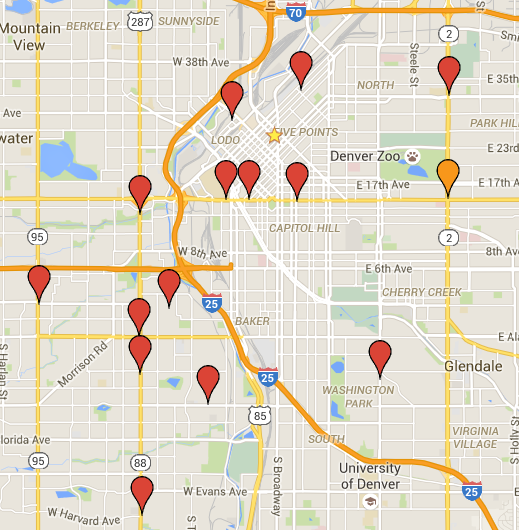Most of Denver’s Pedestrian Deaths Have Happened on These Four Streets

Sunday is World Day of Remembrance for Road Traffic Victims, a day in which people recall their friends and family members who’ve been killed or seriously injured because of traffic violence. It’s also a time to reflect on how to end traffic deaths and serious injuries on our streets, which have become scenes for traffic violence so often, we’ve been desensitized to think they’re just part of getting from A to B.
With 48 days left in 2015, 16 people have been killed while either walking or biking on Denver’s streets. All were on foot except for one. Unsurprisingly, 10 of those people — about 63 percent — lost their lives on one of the city’s “urban highways”: Colfax, Federal, Sheridan, and Colorado. Eight of those 10 deaths occurred on either Colfax and Federal.
What do these streets have in common? They are state highways, controlled by the Colorado Department of Transportation, built to move cars as fast as possible through urban areas filled with people.
The Vision Zero approach that’s taken hold in other cities recognizes that people make mistakes. Primarily through engineering and enforcement, city agencies can create street designs and transportation systems where human error doesn’t automatically mean death. While Mayor Michael Hancock hasn’t officially adopted Vision Zero, he’s headed in that direction. CDOT has taken a more watered down approach.
Meanwhile, here are the pedestrians and people on bikes who’ve unnecessarily lost their lives on Denver’s streets this year:
- Christine Apodaca, 23. October 16.
- Michael Alvarado. October 9.
- Denise Barauskas, 59. September 29.
- Manuel Salazar, 57. September 19.
- Bisnu Rizal, 82. September 5.
- Timothy Erickson, 55. July 14.
- Alex Brundige. May 21.
- Alfonzo Pullen, 39. April 12.
- Jose Molina Barraza. April 9.
- Christopher Barns, 32. March 13.
- Ruben Marquez, 57. March 8.
- Valentino Abeyta, 42. March 3.
- Austin Strasser, 3. February 13.
- Naythan Cordova, 41. February 12.
- Andrew Marthaler, 24. February 8.
- Martin Solis, 48. January 8.
CDOT, Hancock, and his Department of Public Works have to take ownership of these deadly urban highways. These agencies have the ability and the responsibility to redesign the city’s streets to induce lower speeds, and create a safe environment for people with legitimate sidewalks, crosswalks, and protected bike lanes — in short, to act on the modern principle that streets are for people, not just vehicles. By making the streets safe for walking and biking, the system will be safer for everyone, including people in cars and trucks.
This article was updated at 3:48 p.m. on November 13 to accurately reflect the number pedestrians and people on bikes who’ve died on Denver’s streets. That number is 16, not 15, as previously reported.


